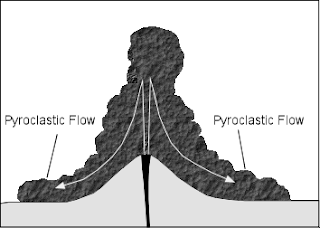The degree of development of karst landforms varies greatly from region to region. Large drainage systems in karst areas are likely to have both fluvial (surface) and karst (underground) drainage components. As stated in the introduction, the term karst describes a distinctive topography that indicates dissolution of underlying rocks by surface water or ground water. Water falls as rain or snow and soaks into the soil.
The water becomes weakly acidic because it reacts chemically with carbon dioxide that occurs naturally in the atmosphere and the soil. This acid is named carbonic acid and is the same compound that makes carbonated beverages taste tangy. Rainwater seeps downward through the soil and through fractures in the rock responding to the force of gravity. The carbonic acid in the moving ground water dissolves the bedrock along the surfaces of joints, fractures and bedding planes, eventually forming cave passages and caverns.
Limestone is a sedimentary rock consisting primarily of calcium carbonate in the form of the mineral calcite. Rainwater dissolves the limestone by the following reaction: Calcite + Carbonic acid = Calcium ions dissolved in ground water + Bicarbonate ions dissolved in ground water. Cracks and joints that interconnect in the soil and bedrock allow the water to reach a zone below the surface of the land where all the fractures and void spaces are completely filled (also known as saturated) with water. This water-rich zone is called the saturated zone and its upper surface is called the water table. The volume of void space (space filled with air or water) in soil or bedrock is termed porosity. The larger the proportion of voids in a given volume of soil or rock the greater the porosity. When these voids are interconnected, water or air (or other fluids) can migrate from void to void. Thus the soil or bedrock is said to be permeable because fluids (air and water) can easily move through them. Permeable bedrock makes a good aquifer, a rock layer that holds and conducts water. If the ground water that flows through the underlying permeable bedrock is acidic and the bedrock is soluble, a distinctive type of topography, karst topography, can be created.
The first part of our animation shows evolution of karst landforms created by downward movement of water accompanied by dissolution of rock and mass transport of sediments in stream channels. In tropical areas with thick massive limestones, a remarkable and distinctive landscape of jagged hills and narrow gorges completely dominates the landscape. Movement of solution along fractures and joints etches the bedrock and leaves limestone blocks as isolated spires or pinnacles. Pinnacles range from small features a few inches tall to intermediate forms a few feet tall to large pinnacles hundreds of feet tall. Besides the etching of pinnacles and residual hills, sheets of flowing water move down sloping surfaces creating a variety of etched surface features. Our computer animation shows the dominant landforms, such as pinnacles, cones, and towers, commonly found in the tropical karst environment of northern Puerto Rico.
Our paper model represents another type of karst landscape, that of a rolling limestone plain such as is found in south-central Kentucky, northern Florida, and the Highland Rim of central Tennessee where doline karst is the dominate feature. Doline karst is the most widely distributed type of karst landscape. The landscape is dotted with sinkholes (dolines) which can vary widely in number and size. For the Sinkhole Plain in central Kentucky, there are approximately 5.4 sinkholes per square kilometer over a 153 square kilometer area. For north Florida there are almost 8 sinkholes per square kilometer over a 427 square kilometer area (White, 1988, table 4.1, page 100). Karst topography dominated by sinkholes or dolines usually has several distinct surface features. Our paper model shows features normally associated with karst topography.
Sinkholes (also known as dolines) are surface depressions formed by either: 1) the dissolution of bedrock forming a bowlshaped depression, or 2) the collapse of shallow caves that were formed by dissolution of the bedrock. These sinkholes or shallow basins may fill with water forming lakes or ponds. Springs are locations where ground water emerges at the surface of the earth. Disappearing streams are streams which terminate abruptly by flowing or seeping into the ground. Disappearing streams are evidence of disrupted surface drainage and thus indicate the presence of an underground drainage system. Cave entrances are natural openings in the earth large enough to allow a person to enter. Caves may reflect a complex underground drainage system.


























